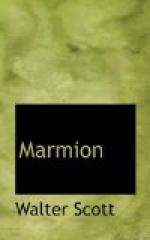XXXVIII.
I do not rhyme to that dull elf,
Who cannot image to himself,
That all through Flodden’s dismal night,
Wilton was foremost in the fight;
1150
That, when brave Surrey’s steed was slain,
’Twas Wilton mounted him again;
’Twas Wilton’s brand that deepest hew’d,
Amid the spearmen’s stubborn wood:
Unnamed by Hollinshed or Hall,
1155
He was the living soul of all;
That, after fight, his faith made plain,
He won his rank and lands again;
And charged his old paternal shield
With bearings won on Flodden Field.
1160
Nor sing I to that simple maid,
To whom it must in terms be said,
That King and kinsmen did agree,
To bless fair Clara’s constancy;
Who cannot, unless I relate,
1165
Paint to her mind the bridal’s state;
That Wolsey’s voice the blessing spoke,
More, Sands, and Denny, pass’d the joke:
That bluff King Hal the curtain drew,
And Catherine’s hand the stocking threw;
1170
And afterwards, for many a day,
That it was held enough to say,
In blessing to a wedded pair,
‘Love they like Wilton and like Clare!’
L’Envoy.
TO THE READER.
Why then a final note prolong,
Or lengthen out a closing song,
Unless to bid the gentles speed,
Who long have listed to my rede?
To Statesmen grave, if such may deign
5
To read the Minstrel’s idle strain,
Sound head, clean hand, and piercing wit,
And patriotic heart—as Pitt!
A garland for the hero’s crest,
And twined by her he loves the best;
10
To every lovely lady bright,
What can I wish but faithful knight?
To every faithful lover too,
What can I wish but lady true?
And knowledge to the studious sage;
15
And pillow to the head of age.
To thee, dear school-boy, whom my lay
Has cheated of thy hour of play,
Light task, and merry holiday!
To all, to each, a fair good-night,
20
And pleasing dreams, and slumbers light!
NOTES
by
Thomas Bayne introduction to canto first. With regard to the Introductions generally, Lockhart writes, in Life of Scott, ii. 150:—’Though the author himself does not allude to, and had perhaps forgotten the circumstance, when writing the Introductory Essay of 1830—they were announced, by an advertisement early in 1807, as “Six Epistles from Ettrick Forest,” to be published in a separate volume, similar to that of the Ballads and Lyrical Pieces; and perhaps it might have been better that this first plan had been adhered to. But however that may be, are there any pages, among all he ever wrote, that one would be more sorry he should not have written? They are among the most delicious portraitures that genius ever painted of itself—buoyant, virtuous, happy genius—exulting in its own energies, yet possessed and mastered by a clear, calm, modest mind, and happy only in diffusing happiness around it.




